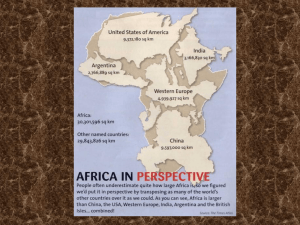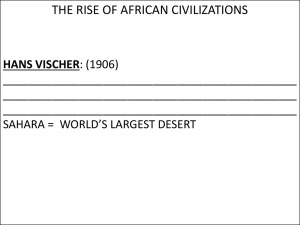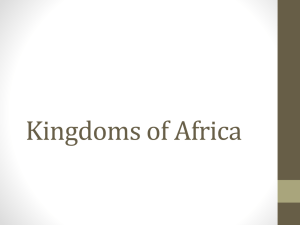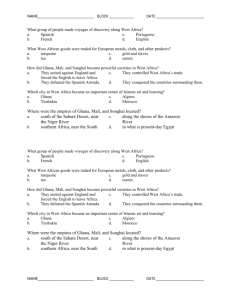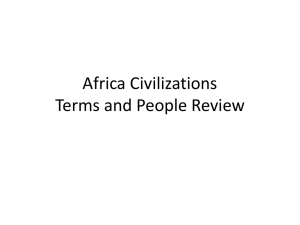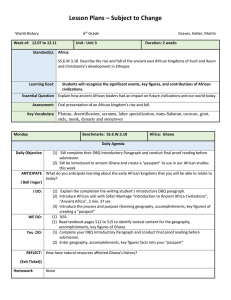Chapter 7
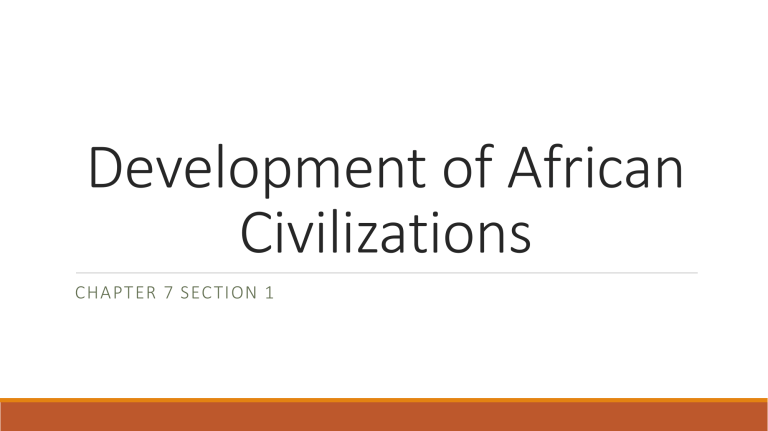
Development of African
Civilizations
CHAPTER 7 SECTION 1
Starter
What geographic factors do you think affected the development of African civilizations?
Answer
Climate, land, and access to water
The Impact of Geography
Main Idea: Africa includes a wide variety of landforms and a number of different climate zones that have influenced its history and culture.
Landform
Africa is the second largest continent.
The continent is almost completely surrounded by two oceans and two seas. (Atlantic and Indian Oceans, and the Red and
Mediterranean Sea)
Northern area is mountainous.
South of the mountains is the largest desert on Earth, the Sahara.
To the east is the Nile River
Grasslands in interior Africa; tropical jungles along the coast
Far to the east is a very different terrain of snow-capped mountains, upland plateaus, and lakes.
A distinctive feature Is the Great Rift valley, where mountains loom over deep canyons.
Climate
Four distinct climate zones:
1. Mild – stretches across the northern coast and southern tip of Africa.
Moderate rainfall, warm temperatures, fertile land.
2. desert – covers 40% of Africa, The Sahara and the Kalashari are the two largest deserts.
3. rain forest – makes up 10% of the continent, heavy rains, warm temperatures, and dense forests.
4. savannas – broad grasslands dotted with small trees and shurbs, covers 40% of Africa’s land area.
Emerging Civilizations and Religions
Main Idea: Kush and Axum arose as strong early civilizations. Later Islam would influence Africa.
Kush
2,000 busy trade between Egypt and
Nubia
Egyptian merchants imported ivory, ebony, frankincense, and leopard skins from Nubia.
In 750 B.C. Kush conquered Egypt.
Economy was based on farming and then later became a major trading state.
Center of the city was Meroe; iron ore resources.
Kush provided iron products, ivory, gold, ebony, and slaves to the Roman empire, Arabia, and
India.
The Kush imported luxury goods from India and Arabia.
Kushite society was mostly urban.
Kush declined because of the rise of Axum.
Axum
Located in what is now Ethiopia, founded by Arabs, combined Arab and African cultures.
Located along the Red Sea
Exported ivory, frankincense, myrrh, and slaves
Imported textiles, metal goods, wine, and olive oil
The most distinctive feature of the Axumite civilization was its religion.
Christianity was first brought to the area by the Syrians.
In later centuries, a new religion – Islam – brought profound challenges to the kingdom.
Rise of Islam
Islam rose from the Arabian Pennisula, and then spread across the region.
641 – Arab forces captured Egypt
700s – Arabs ruled North Africa’s coast west to the strait of Gibraltar.
Muslims also occupied lands along the Red Sea.
Muslims states moved inland to gain control over the trade in slaves in ivory,
Axum fought back.
Axum became involved in a growing conflict with the Muslim state of Adal.
Page 239
Main Ideas : 2,3,4
Section Review
Kingdoms and States of Africa
Main Idea: Trade in gold helped create a strong economy in Ghana, bringing wealth to its merchants and its kings.
The Kingdom of Ghana
The first great trading state in West Africa.
Located in the upper Niger River valley, grassland region between the Sahara and the tropical forests along the West African coast.
most of the people were farmers, lived in villages under the authority of a local ruler.
The villages formed the Kingdom of Ghana
The kings of Ghana were strong rulers who governed without any laws.
T o protect their kingdom and to enforce their wishes, the kings relied on a welltrained army.
Prospered from their possession of iron and gold
The region had an abundant supply of iron ore.
Blacksmiths of Ghana were highly valued because of their ability to turn this ore into tools and weapons.
Ghana’s Gold made it the center of an enormous trade empire.
Traded with Muslim merchants from North Africa (metal goods, textiles, horses and salt).
Salt was a highly desired item, was used to preserve food; salt was also needed for their diet.
Trade across the desert was carried by the Berbers, nomadic peoples whose camel caravans became known as the “fleets of the desert”.
Hundred camels; 3 miles per hour; 40 to 60 days
Ghana was weakened by a series of wars and collapsed during the 1100s.
The Kingdom of Mali
Main Idea: Powerful leadership helped Mali thrive.
Rose up after Ghana’s collapse; became a new trading state in West Africa.
Founding and Economy
Founded by Sundiata Keita
Defeated Ghana and captured its capital in 1240.
United the people of Mali and created a strong government.
Mali made its wealth and power on the gold and salt trade.
Most people were farmers; lived in villages with local rulers(religious and administrative leaders)
Mansa Musa
One of the richest and most
powerful kings. (1312-1337)
Doubled the size of the Kingdom of
Mali
Created a strong central government and dived the kingdom into provinces ruled by governors whom he appointed.
He was a Muslim; one day decided to make a pilgrimage to Makkah.
Traveled with thousands of servants and soldiers
Hundreds of camels carrying gold as well as food, clothing, and other supplies.
Gave a way so much gold that the value of gold began to fall.
His pilgrimage demonstrated his wealth and power.
Inspired to make Timbuktu a center of Islamic learning and culture
He built mosques and libraries
Timbuktu became recognized as one of the intellectual capitals of the Muslim world.
Mansa Musa proved to be the last powerful ruler of Mali.
1359 – civil was divided Mali
100 years later a new kingdom arose, Songhai
The Kingdom of Songhai
Main Idea: Situated along the Niger
River, the Songhai became powerful traders.
Ruler named Kossi converted to
Islam and established the Dia dynasty; first Songhai state.
Benefited from the Muslim trade routes.
Sunni Ali created a new dynasty – the
Sunni – in 1464.
Sunni Ali spent much of his reign on horseback and on the march as he led his army in one military campaign after another.
Two conquests- Timbuktu and Jenne; gave Songhai control of their trading empire
Ali united rural and city dwellers
Songhai Empire reached the height of its power during the reign of
Muhammad Ture.
Ture divided Songhai into provinces
Declined by 1600
Societies in East Africa
South of Axum, along the shores of the Indian Ocean and inland from the mountains of Ethiopia, lived a mixture of peoples.
Lived by hunting and food gathering, while others raised livestock.
The Bantu people moved into East Africa
The Bantu communities were based on subsistence farming – growing crops for personal use not for sale.
The Bantus spread iron-smelting techniques across Africa and the knowledge of high-yield crops like yams and bananas.
Bantu people established the prosperous city of Great Zimbabwe.
Indian Ocean Trade and Ports
The eastern coast of Africa became a part of the trading network along the Indian Ocean.
Mogadishu, Mombasa, Kilwa
Merchants in these cities grew very wealthy.
As time passed, a mixed African
Arabian culture, eventually known as Swahili, began to emerge throughout the coastal area.
Societies in South Africa
Main Idea: In southern Africa, independent villages organized into states, the most powerful of which was Zimbabwe.
Stateless societies – groups of independent villages organized by clans and led by a local ruler or clan head.
Zimbabwe – was the wealthiest and most powerful state in the region. It prospered from gold trade with the Swahili trading communities on the eastern coast of Africa.


